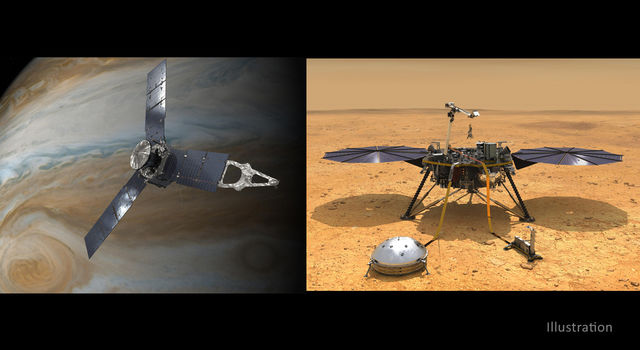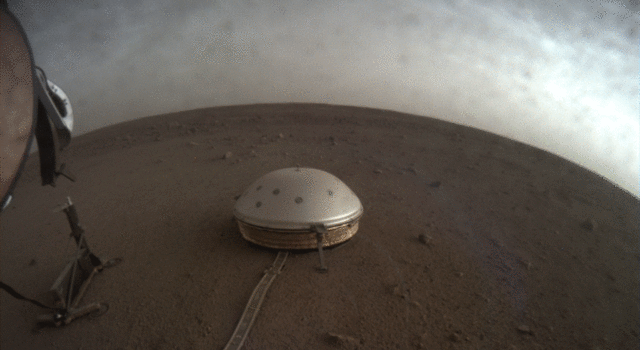Blogs | Dawn Journal | January 30, 2013
The Giant Asteroid: A Retrospective
Dear Dawn't Look Backs,
Its long and daring interplanetary journey continuing smoothly, Dawn is making good progress in gradually reshaping its orbit around the sun. Its uniquely efficient ion propulsion system is gently bringing it closer to its next destination, dwarf planet Ceres, and ever farther from its previous one, Vesta. Although the robotic explorer's sights are set firmly ahead, let's take one last look back at the fascinating alien world it unveiled during its 14 months in orbit there.
Vesta, the second most massive resident of the main asteroid belt between Mars and Jupiter, was discovered in 1807. For more than two centuries thereafter, the mysterious object appeared as little more than a fuzzy patch of light among the stars. The only one of the millions of main belt asteroids to be bright enough to be visible to the naked eye, Vesta beckoned, but its invitation was not answered until Dawn arrived in July 2011, nearly four years after it left distant Earth. The cosmic ambassador is the only spacecraft ever to have orbited an object in the main asteroid belt, and its ambitious mission would have been impossible without ion propulsion.
Dawn found a complex and exotic place, and it returned a fabulously rich collection of pictures and other measurements that will continue to be analyzed for many, many years. For now, we will simply touch on a very few of the many insights that already have been illuminated by the light of Dawn.
Scientists recognize Vesta as being more like a mini-planet than like the chips of rock most people think of as asteroids. The behemoth is 565 kilometers (351 miles) wide at the equator and has a surface area more than twice that of California (although it is populated by far fewer eccentrics, billionaires, and other colorful characters found in that state). Dawn's measurements of the gravity field provide good evidence that Vesta separated into layers, much like Earth did as the planet was forming. Vesta's dense core, composed principally of iron and nickel, may be 200 to 250 kilometers (125 to 150 miles) across. Surrounding that is the mantle, which in turn is covered by the veneer of the crust, about 20 kilometers (12 miles) thick. The once-molten core is now solid (in contrast to Earth's, which remains hot enough to be liquid), but the differentiation into layers gives Vesta a key distinction from most asteroids. Because it was likely still in the process of accumulating material to become a full-sized planet when Jupiter's immense gravity terminated its growth, scientists often refer to Vesta as a protoplanet.
Among the most prominent features of the alien landscape is a huge gouge out of the southern hemisphere so large that its presence was inferred from observations with the Hubble Space Telescope. Dawn found this gigantic crater to be even deeper and wider than expected, penetrating about 19 kilometers (12 miles) and spanning more than 500 kilometers (310 miles), or nearly 90 percent of the protoplanet's equatorial diameter.
The yawning hole is now known as Rheasilvia, after the Vestal Virgin who not only was the mythical mother of Romulus and Remus, but also surely would have been astounded by the spectacular sights on Vesta as well as the spacecraft's capability to point any user-defined body vector in a time-varying inertial direction defined by Chebyshev polynomials. As Dawn has brought Vesta into focus, cartographers have needed labels for the myriad features it has discovered. The International Astronomical Union names Vestan craters for Vestal Virgins and other famous Roman women; mountains, canyons, and other structures are named for towns and festivals associated with the Vestal Virgins.
Vesta dates to the dawn of the solar system, more than 4.5 billion years ago, and its age shows. Myriad craters tell the story of a timeworn surface that has been subjected to the rough and tumble conditions of life in the asteroid belt ever since. A virtual rain of space rocks has fallen upon it. While Rheasilvia records the most powerful punch, from an object as much as 50 kilometers (30 miles) across, there are at least seven craters, some quite ancient indeed, more than 150 kilometers (nearly 100 miles) in diameter. As the eons pass, craters degrade and become more difficult to discern, their crisp shapes eroded by subsequent impacts large and small.
The long history of cratering is particularly evident in the startling difference between the northern and southern hemispheres. The north is very densely cratered, but the south is not. Why? The titanic blow that carved out Rheasilvia is estimated to have occurred over one billion years ago. It excavated a tremendous volume of material. Much of it fell back to the surface, wiping it clean, so the cratering record had to start all over again. Recall that the crater itself is 500 kilometers (310 miles) in diameter, and scientists estimate that 50 kilometers (30 miles) outside the rim, the debris may have piled about 5 kilometers (3 miles) high. Even at greater distances, preexisting features would have been partially or completely erased by the thick accumulation. The effect did not reach to the northern hemisphere, however, so it retained the craters than had formed before this enormous impact.
Some of the rocks were ejected with so much energy that they broke free of Vesta's gravitational grip, going into orbit around the sun. They then went their own way as they were yanked around by the gravitational forces of Jupiter and other bodies, and many of them eventually made it to the part of the solar system where your correspondent and some of his readers spend most of their time: Earth. When our planet's gravity takes hold of one of these Vesta escapees, it pulls the rock into its atmosphere. Some lucky witness might even observe it as a meteor. Its blazing flight to the ground is not the end of its glory, however, for these rocks are prized by planetary geologists and other enthusiasts who want a souvenir from that impact.
Scientists now know that about 6 percent of the meteorites seen to fall to Earth originated on Vesta. Six percent! One of every 16 meteorites! This is an astonishingly large fraction. Apart from Mars and the moon, Vesta is the only known source of specific meteorites. Although rocks from Vesta had to travel much farther, they far outnumber meteorites from these other two more familiar celestial bodies.
Combining laboratory studies of the numerous samples of Vesta with Dawn's measurements at the source provides an extraordinary opportunity to gain insights into the nature of that remote world. Meteorites from Vesta are so common that they are often displayed in museums (occasionally even without the curators' awareness of their special history) and can be obtained from many vendors. Anyone who has seen or held one surely must be moved by contemplating its origin, so distant in space and time, from well beyond Mars and long before animal or plant life arose on Earth.
The impact that formed Rheasilvia partially obliterated the second largest crater on Vesta, Veneneia. That 400-kilometer (250-mile) crater was about 12 kilometers (7.5 miles) deep. It was formed more than two billion years ago, around the time life on Earth grew to macroscopic proportions and photosynthesis by cyanobacteria was still introducing oxygen to the atmosphere.
Scientists are deciphering a possible consequence of the colossal collisions that formed Rheasilvia and Veneneia. The events were so forceful that they sent shock waves reverberating through the entire world. (It is fortunate that Vesta was not destroyed, because if it had been, we would not have such a fascinating place to explore, although it may well be that other protoplanets in the asteroid belt did meet that fate.) As the energy surged through Vesta's interior, the material deformed in complex ways that just a chunk of rock could not. But Vesta is not just a chunk of rock. As a mini-planet, its interior composition and properties have been altered by the geological forces that formed and shaped the world. The seismic stretching apparently caused faults 400 kilometers (250 miles) from the impact sites, and those scars are now evident in another of the most conspicuous features: a vast network of chasms near the equator.
Eighty-six gorges mapped at the equator appear to have been caused by the Rheasilvia impact, and another seven may be from Veneneia. Individual troughs extend to as much as 465 kilometers (289 miles) in length. One is more than 39 kilometers (24 miles) wide and 4.0 kilometers (2.5 miles) deep. These dimensions rival those of the Grand Canyon. This would be as if huge impacts on Earth in Barrow, Alaska and in London (at similar latitudes but the opposite hemisphere as Rheasilvia and Veneneia, respectively) had triggered the formation of giant canyons near the equator.
Vesta has another feature that exceeds the dimensions of anything found on Earth. At the center of Rheasilvia is a mountain of staggering proportions. The summit soars to a fantastic 20 to 25 kilometers (12.4 to 15.5 miles) above the variable elevation of the terrain around it (even ignoring the smaller craters that go deep into the floor of Rheasilvia) and 180 kilometers (110 miles) across at its base. This colossus is well over twice the height of puny Mt. Everest, which rises to less than 9 kilometers (5.5 miles) above the distant seas. Vesta's peak is the second tallest known in the solar system. Olympus Mons on Mars is (slightly) higher.
Dawn's extensive stereo measurements showed that Vesta's extreme topography is not limited to Rheasilvia. This craggy world has many steep slopes. When a space rock smashes into such a slope, the crater it forms may be unstable. The uphill portion succumbs to the pull of Vesta's gravity and the resultant landslide leaves a very deformed crater, as Dawn observed in many locations.
Vesta's surface displays more variety than dramatic craters, towering mountains, expansive chasms, and other impressive topographic features. Among the surprises are strong variations in the brightness of the material itself. Dark splotches here and there are likely deposits from dark rocks that formed in a different location in the solar system and eventually crashed into Vesta. Bright areas are interpreted to be material that originated on Vesta and which has hardly changed at all since the giant protoplanet formed. Gradually it was covered by debris settling to the ground from impacts elsewhere, but occasionally an impact exposes it.
The sophisticated probe from Earth has allowed scientists to make many more wonderful discoveries, far too many to be presented here (or, at least, far too many for your correspondent to describe without exceeding his self-imposed limit of 2,173 words). Some of them have been reported in JPL/NASA news releases as well as in other websites, printed publications, news broadcasts, at dinner tables, and perhaps even on playgrounds (the kind this writer would have enjoyed anyway). And if you haven't been to Vesta to behold the marvelous sights yourself, then either go there or go here to see a few of the best views.
As half a second in a person's lifetime, for one of its nearly 4.6 billions years, Vesta had a companion from Earth, but now it is alone again. Dawn has given us stunning views of this survivor from the dawn of the solar system. Even as dazzling knowledge is gained about Vesta, that distant orb grows only fainter for the probe itself, their separation already being more than 10 times the distance between Earth and the moon. The world Dawn orbited not so long ago now appears only as a pinpoint. It glows among the stars about as bright as Canopus, the second brightest star (apart from the sun) visible from our solar system. Only Sirius is brighter, about twice as luminous. (For Dawn, as well as for terrestrial observers, the planet Jupiter also shines brighter now.)
The discoveries so far are only the beginning. Dawn's sensors returned so much data that it will take decades to mine their riches. Surprising new understandings will be gained by further studies, combined with more investigations of the meteorites from Vesta, comparisons with other worlds, and additional new information about the cosmos. One of the beauties of science is that it allows us not only to comprehend more and more about the universe but also to ask -- and ultimately answer -- more and more insightful questions. Dawn has already made great contributions to this splendid enterprise. The explorer promises still more rewards as it travels ever farther on its exhilarating quest for knowledge, taking us all on a bold and exciting interplanetary adventure to uncharted worlds.
Dawn is 4.2 million kilometers (2.6 million miles) from Vesta and 57 million kilometers (35 million miles) from Ceres. It is also 1.92 AU (288 million kilometers or 179 million miles) from Earth, or 750 times as far as the moon and 1.95 times as far as the sun today. Radio signals, traveling at the universal limit of the speed of light, take 32 minutes to make the round trip.
TAGS:DAWN, CERES, VESTA, DWARF PLANETS, SOLAR SYSTEM, MISSION, SPACECRAFT







